They Put a Car in Space, We Upgraded Our Engine | Update 20.5
Mar 7th
Run Steam to download Update 20.5, or buy Universe Sandbox ² via our website or the Steam Store.
March 14: Update 20.5.2 is a small update that fixes a few bugs, including problems with volume settings and camera control.
Update 20.5 features:
- A Tesla Roadster in Space
- The Ultimate Engineered System
- An Upgrade of Our Game Engine to Unity 2017.2
This is a small update in terms of content, but there have been some significant under-the-hood changes with the upgrade of our game engine to Unity 2017.2. As with past under-the-hood changes, it’s a sign we’ve transitioned well if you can’t see any differences.
But also: there’s a car in space! (And conversely, this car doesn’t even have an engine under its hood.) On February 6, 2018, SpaceX performed a successful test launch of their Falcon Heavy rocket, the most powerful rocket currently in use. The launch was intended as a demonstration of the Falcon Heavy’s ability to launch a payload into an orbit that could reach Mars. SpaceX also successfully landed two of the Falcon Heavy’s reusable booster engines, although the central core crashed during its attempted landing.
As part of the test, the Falcon Heavy rocket carried a dummy payload to demonstrate that it could launch a large mass onto the required orbit. For this launch, SpaceX chose an unusual dummy payload: a Tesla Roadster electric car belonging to SpaceX and Tesla CEO Elon Musk. In a press statement released before the launch, SpaceX explained that it wanted a payload that was “fun and without irreplaceable sentimental value.” While the Roadster will not land on or orbit Mars, its current elliptic orbit around the Sun will take it beyond the orbit of Mars at its farthest point.
Check out the Roadster sims in Universe Sandbox ²:
- Home > Open > Tesla Roadster in Space
- Home > Open > Where in Space is the Tesla Roadster
Update 20.5 also includes a database refresh for objects in our Solar System, a few other new sims (including the Ultimate Engineered System), improved supernova visuals, and a number of smaller improvements and bug fixes.
Check out the full list of What’s New in Update 20.5
We are making great progress on Update 21, but we unfortunately can’t provide a release date yet. Update 20.5 is just a step on the way to make sure everything is running smoothly. Thank you for your patience while we continue to work on Planet Grids and Lasers.
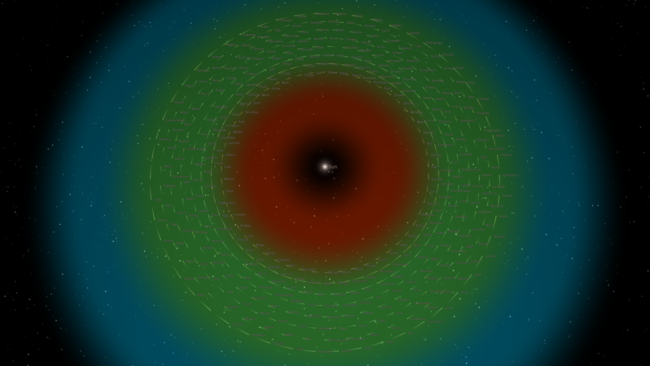
The Ultimate Engineered System, as described by astronomer Sean Raymond
Universe Sandbox ² 2017 Retrospective
Jan 12th
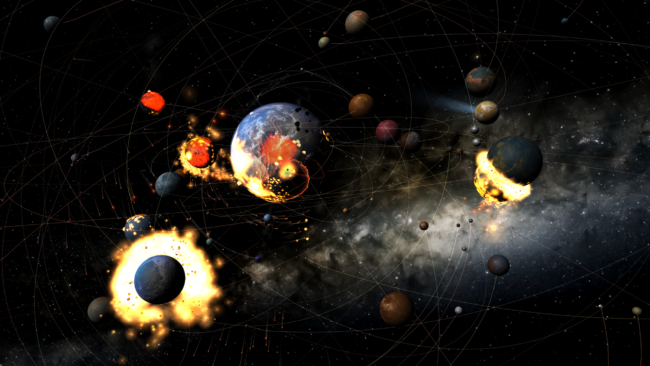
2017 was another great year for Universe Sandbox ². Our big milestone was Update 20, which – as we explained in our blog post – replaced the whole foundation for Universe Sandbox ² and opened up tons of new possibilities. We also launched on the Oculus Store, expanded our team, and continued to see positive reviews pour in. Our sales once again surpassed our expectations, which has helped in our team expansion and keeps us looking forward to a long list of great features and improvements.
It may not have been the flashiest development year for us, but what we accomplished was extremely important and we’re very proud. Plus we expect some flashy stuff to arrive soon enough.
Here’s a look at our achievements in 2017 by the numbers:
3
# of new spacecraft models.
Find them in Add > Objects:
- Voyager 1 & 2
- Arrival
- Cassini
4
# of team members who joined us on our journey to build the universe.
Warm welcomes to:
- Mat | Quality Assurance
- Jacob | VR Developer
- Barry | Graphics Developer
- Erika | Astrophysicist, Climate & Simulation Developer
9
# of significant updates to Universe Sandbox ².
- Prettier Moons & Bug Fixes | Alpha 19.5 | February 08, 2017
- TRAPPIST-1 & the Seven Planets | Alpha 19.6 | February 23, 2017
- Voyager & Two Icy Moons | Alpha 19.7 | April 19, 2017
- A New Foundation & VR 2.0 | Update 20 | June 22, 2017
- Total Solar Eclipse | Update 20.1 | August 14, 2017
- Ciao, Cassini | Update 20.2 | September 14, 2017
- A New Exoplanet & Interstellar Messenger | Update 20.3 | November 21, 2017
- Oculus Store Launch | Update 20.3.1 | December 7, 2017
- Scales & Scholars | Update 20.4 | December 21, 2017
12
# of new & improved textures.
- Ganymede
- The Moon
- Mimas
- Enceladus
- Callisto
- Rhea
- Titan
- Dione
- Iapetus
- Tethys
- Vesta
- Mercury
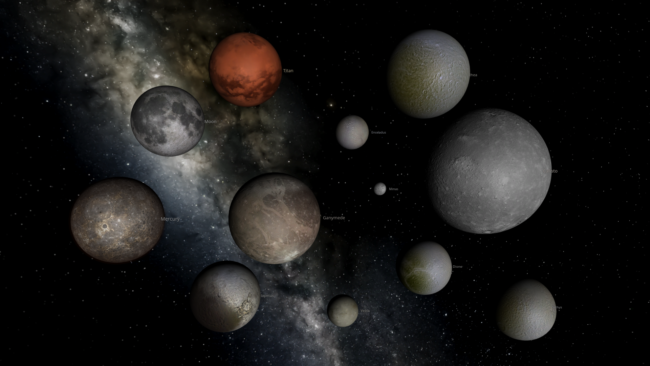
26
# of new simulations.
This year we made an effort to add even more simulations for historical and current astronomical events. Explore the newly announced exoplanets in the TRAPPIST-1 and Ross 128 sims; watch 2012 TC4 and Apophis skim past Earth; and say hello to our first known interstellar visitor, ‘Oumuamua, and goodbye to Cassini, the spacecraft that illuminated Saturn.
- 2 TRAPPIST-1 sims
- 2 Vsauce sims
- 3 Total Solar Eclipse sims
- 7 Voyager 1 & 2 sims
- 2012 TC4 passes Earth on October 12, 2017
- Cassini’s Collision with Saturn
- Potentially Hazardous Asteroids
- 400 Nearest Stars
- Ross 128 with Earth-sized Planet
- Just Chariklo
- ‘Oumuamua in 2017
- Solar System – Now & Real Time
- Planets Between the Earth & Moon
- Apophis Encounters Earth in 2029
- Earth’s Most Stable Quasi-Satellite, 2016 HO3
- Solar System Planet Comparison
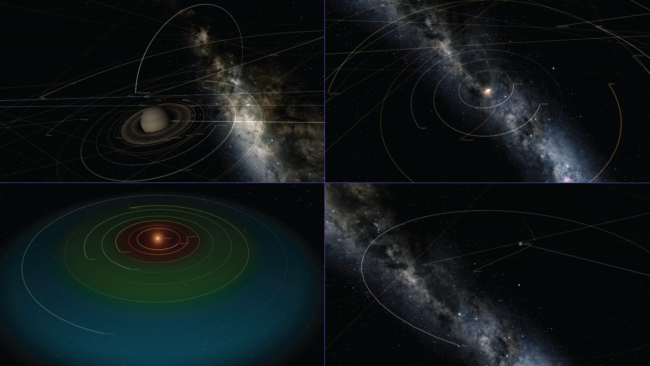
35
# of pages of release notes for Universe Sandbox ² updates in 2017.
Check out What’s New.
587
Highest # of concurrent users in Universe Sandbox ² in 2017 (happened on December 25).
This isn’t quite as many as our all-time high in March 2016 (our first big sale after our launch on Steam the summer before), but it’s the highest since. We’re happy to see that we continue to bring in new players and keep our fans coming back for more.
1,008
# of tasks closed in our task management system.
Tasks keep track of all the bugs we want to fix and the improvements and features we want to add, as well as higher level goals like design work and ideas we want to explore. Once we complete whatever the task asked for, like fixing a bug, we pass it on for approval to Mat, our QA, then close it and move onto the next task.
1,186
# of positive Steam reviews of Universe Sandbox ² written in 2017.
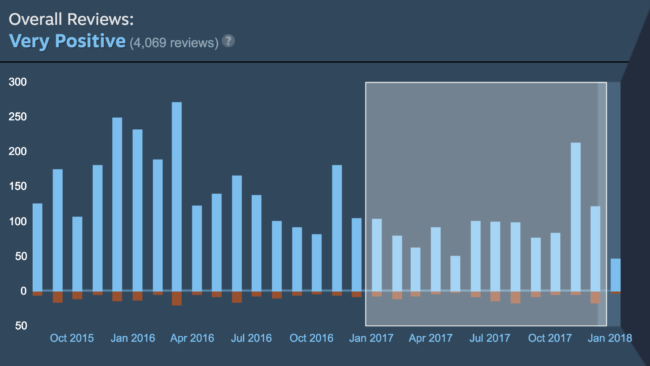
1,413
# of new tasks opened in our task management system.
While it would have been nice to close a task each time we opened a new one, it’s unfortunately easier, generally speaking, to imagine an improvement or feature than it is to implement it, and it’s easier to spot a bug than it is to fix it. Development on other games may look a bit different, but with Universe Sandbox ², we don’t hesitate to write down any idea that comes our way. We still focus our efforts toward specific milestones, but at the same time, we don’t stop ourselves from dreaming up a development road that goes past the horizon.
3,673
# of commits made to our project.
A commit is essentially a package of code changes that a team member adds to the project. It could include one small change, like adding a parenthesis, or it could include hundreds of lines of code.
>100,000
# of copies sold on Steam and other platforms.
Or, on average, one copy sold every five minutes.
5,361,590
# of views of Vsauce’s Which Way Is Down video featuring Universe Sandbox ².
Universe Sandbox ² is used (starting at 45 seconds in) as part of an exploration into how gravity works. We’re big fans of Vsauce and were super happy to see Universe Sandbox ² in one of their videos. The icing on the cake: when Michael said “This simulator will blow your mind. I love it.”
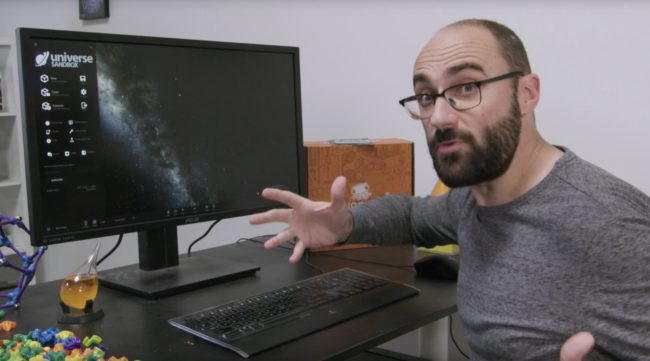
18,472,265
# of views in 2017 of all YouTube videos specifically about Universe Sandbox ².
Take this number with a grain of salt. It’s hard to say how accurate this value is from SteamSpy, but it’s a fun number regardless! And this doesn’t even include the above 5+ million views from the Vsauce video.
What’s Next?
What we don’t see in the list above is all of the work we did in 2017 that has yet to be released. There’s a lot of it. Planet grids, lasers, Steam Workshop, localization, stellar evolution, and on and on. Check out our roadmap from last year to get an idea of what we’re working on.
We’re moving closer to our next big release, Update 21, and we’re excited to show off what we’ve been doing. Once Update 21 has come and gone, we’ll share a new roadmap for 2018 that we expect will be no less exciting than last year’s. Stay tuned! And as always, thanks to all our fans for joining us on this cosmic journey. Your continued support and enthusiasm make all of this possible.
Scales & Scholars | Update 20.4
Dec 21st
Run Steam to download Update 20.4, or buy Universe Sandbox ² via our website or the Steam Store.
Update 20.4 features five new simulations:
- Check out our Solar System in its current state in real time
- Cram all of the planets between the Earth and Moon (see clip above)
- See the asteroid Apophis’s close call with our planet in 2029
- Spend some time with Earth’s companion, 2016 HO3
- Explore the scale of the planets in our Solar System
This update also features tons of new descriptions so you can learn more about the astronomy, physics, and history of the simulations. There is also a new texture for the minor planet Vesta.
Check out the full list of What’s New in Update 20.4.
We are still hard at work on our next big release, Update 21. Stay tuned after the New Year for more information.
Happy Holidays!
Oculus Store Launch | Update 20.3.1
Dec 7th
Universe Sandbox ² is now officially available on the Oculus Store!
And to celebrate, we are 15% off: Universe Sandbox ² on Oculus Store
If you’re a Rift user already, you should see some big performance boosts in VR, thanks to the added support for the Oculus technology in this update. Oculus technology features their Asynchronous Spacewarp, which helps keep the visuals and tracking feeling smooth, even when there’s a dip in performance.
This update also includes a number of smaller improvements and bug fixes. Check out the full list of What’s New in Update 20.3.1.
Special thanks to our VR developer, Jacob, for making all of this possible!
Follow @universesandbox
A New Exoplanet & Interstellar Messenger | Update 20.3
Nov 21st
Run Steam to download Update 20.3, or buy Universe Sandbox ² via our website or the Steam Store.
Update 20.3 features two new simulations for the recently discovered exoplanet, Ross 128 b, and the first observed interstellar visitor, ‘Oumuamua. This update also includes a number of smaller improvements and bug fixes.
Ross 128 b
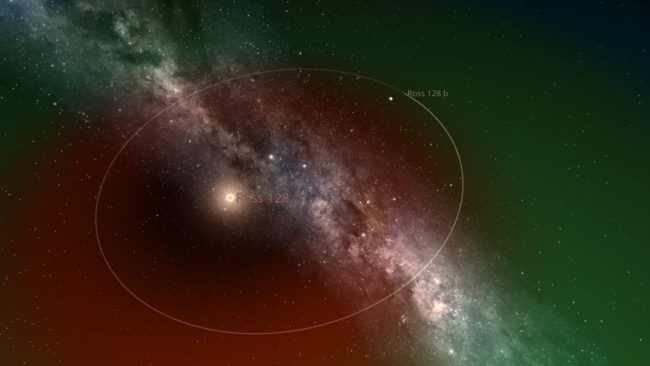
On November 15, 2017 astronomers with the European Southern Observatory (ESO) discovered Ross 128 b, a potentially habitable, Earth-sized exoplanet orbiting a red dwarf star 11 light years away.
Though Ross 128 b is farther than the closest temperate planet, Proxima b, it orbits a “quieter” red dwarf that emits far less deadly ultraviolet and X-ray radiation. This makes it a much better candidate for habitability.
See Ross 128 b in Universe Sandbox ²:
Home > Open > Ross 128 with Earth-sized Planet
‘Oumuamua
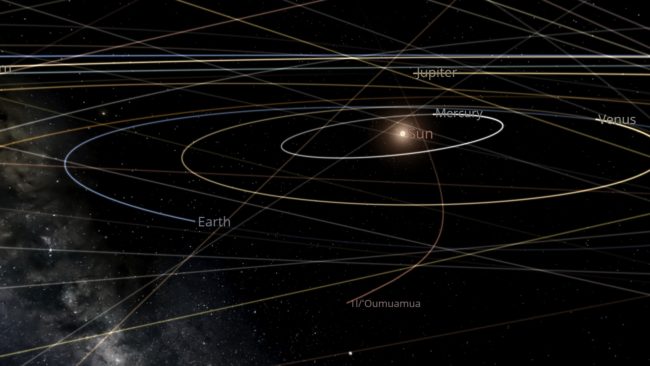
On October 19, 2017, astronomers in Hawaii observed an asteroid soaring past Earth. Analysis of its trajectory revealed that it is the first interstellar object ever observed in our solar system. Nicknamed ‘Oumuamua, meaning “a messenger from afar arriving first,” the asteroid carries the story of a distant star system born a long time ago.
Learn more about ‘Oumuamua on NASA’s website.
See ‘Oumuamua in Universe Sandbox ²:
Home > Open > Oumuamua in 2017
Check out the full list of What’s New in Update 20.3.
The New Dynamic Bottom Bar
Nov 17th
We improved the bottom bar of the user interface in our last few updates. Now when you change the width of the Universe Sandbox ² application window, the bar automagically resizes. Buttons that don’t fit are grouped into a More button, and if the window is narrow enough, the bar adapts to two rows. (Please note that this design is a work in progress and likely to change in future versions.)
It’s a small touch, and you may not think it’s that useful at first, as you probably won’t be resizing your window too often. But the portrait-style ratio of the window at the end of the video above may look familiar, and that’s because it’s very similar to your smartphone.
This dynamic resizing tech is extremely useful for Universe Sandbox ² on mobile devices. Use it in portrait mode or flip your phone sideways and use it in landscape — everything shifts and resizes seamlessly.
Thanks to our mobile developer, Dave, for all of his great work on Universe Sandbox ²!
Sign up to be notified when Universe Sandbox ² is available on mobile!
Universe Sandbox ² Featured in Vsauce Video
Nov 2nd

Friday, November 3rd: We’ve released Updates 20.2.3 and 20.2.4, which add two sims from this Vsauce video as well as a few improvements and bug fixes. See the sims in Home > Open.
Hey, did you hear that? Michael from Vsauce just gave some high praise of Universe Sandbox ²: “This simulator will blow your mind. I love it.”
Vsauce is a science and education YouTube channel that has attracted over 12.5 million subscribers with “videos that feed the curious and illuminate the amazing.”
We’re very honored and humbled to be featured in their latest video! Check it out below.
For the latest Universe Sandbox ² news, follow us on Twitter and Facebook.
See Asteroid 2012 TC4’s Trip Past Earth
Oct 13th
On October 12, 2017, asteroid 2012 TC4 passed Earth early in the morning, flying above Antarctica at around 1:42am EDT.
See its close approach in Universe Sandbox ²:
Home > Open > Historical > 2012 TC4 Passes Earth on October 12, 2017
The roughly house-sized asteroid passed just a bit beyond the orbits of communications satellites, well within the Moon’s orbit. This wasn’t close enough to pose any threat, but its orbit was slightly changed by Earth’s gravity, as you can see in the GIF above from Universe Sandbox ². Learn more on NASA’s website
For the latest Universe Sandbox ² news, follow us on Twitter and Facebook.
Cassini’s Limitations in Universe Sandbox ²
Sep 28th
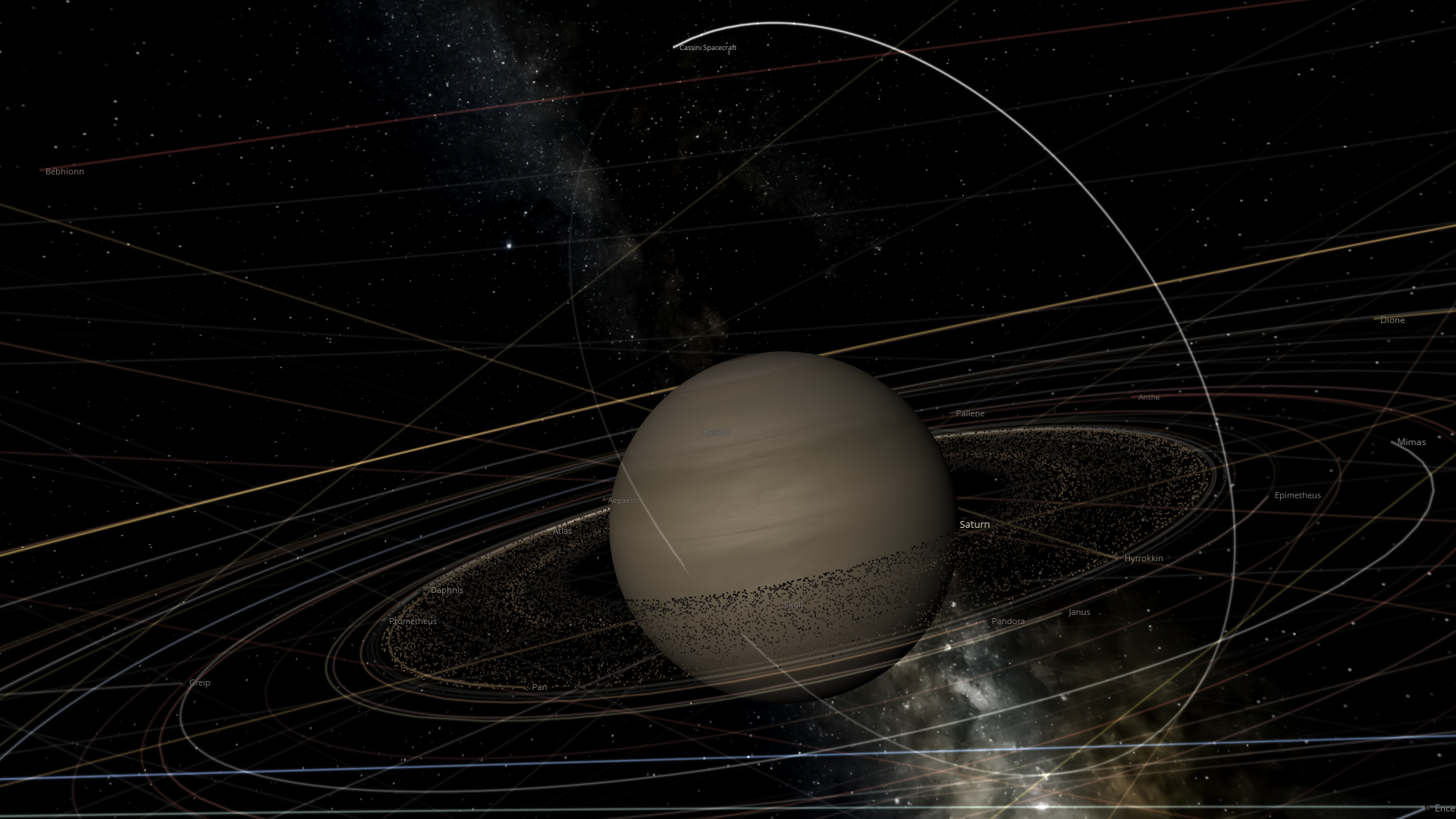
It’s been two weeks now since we said goodbye to the Cassini spacecraft. After its 20-year-long mission in space, it was running low on fuel, so NASA directed it toward Saturn in order to eliminate the risk of it contaminating the moons. On September 15, 2017, Cassini sent its final image back to Earth before disintegrating in Saturn’s atmosphere.
To commemorate this event, we released Ciao, Cassini | Update 20.2 which featured a simulation of Cassini’s final hours and collision with Saturn.
See Cassini’s final hours in Universe Sandbox ²:
Home > Open > Core/Historical > Cassini collision with Saturn on September 15, 2017
Home > Tutorials > Science > What Is Cassini’s Grand Finale?
Simulation Limitations
We had initially been wary of including a simulation of this event, as there are several limitations in Universe Sandbox ² that reduce the realism of this particular simulation. In the end, however, we decided it was still an informative and interesting visualization of an event that is very important to science and the world.
But instead of brushing these limitations under the rug, we’d like to take a closer look at them.
1 – Atmospheric Entry
We love collisions in Universe Sandbox ². But just because an object is on a collision course with a planet, that doesn’t mean it should actually collide with that planet in every scenario. If it’s small enough, then it should instead disintegrate in the planet’s atmosphere. This is what happened to Cassini as it entered Saturn’s atmosphere.
Universe Sandbox ² doesn’t yet simulate the forces associated with atmospheric entry, like atmospheric drag and aerodynamic heating. So instead, small objects will simply collide with planets. We’re very interested in simulating these effects in Universe Sandbox ², not just for objects like Cassini, but also for meteoroids that should burn up in an atmosphere, creating meteors or “shooting stars.”

An animation from Wikipedia of a meteoroid losing material as it enters Earth’s atmosphere
2 – Rocket Engines & Spacecraft Flight
Cassini didn’t stay in orbit around Saturn for 13 years, weaving through its rings and doing close flybys of its moons, all by the grace of gravity. No, its trajectory was carefully planned by engineers and frequently adjusted with its rocket engines. But while Universe Sandbox ² has models of various spacecraft, it doesn’t yet include any way to simulate or control propellant. You can manually change an object’s velocity, but you can’t apply a force to it in the same way that a rocket engine would.
We’re still a while away from controlling thrust on spacecraft and flying them through simulations in Universe Sandbox ², but we’re taking steps in that direction with our work on rigid body physics. This new tech will better simulate the physics of smaller-scale objects, such as spacecraft, allowing for precise collisions and parts that can be attached with breakable joints and other constraints.
3 – Minimum Size for Impact Visuals
When the Shoemaker–Levy 9 fragments collided with Jupiter, observers from Earth could see marks on Jupiter that were more easily visible than the famous Great Red Spot. Some of these fragments were larger than one kilometer in diameter. The Cassini spacecraft, on the other hand, was only about 6.8 meters high and 4 meters wide. Its disintegration in Saturn’s atmosphere should not be easily visible, and even if it were to collide with Saturn instead of disintegrating, it should not leave a large impact mark. [Our Cassini update added a quick fix for this problem to disable an impact mark for its collision.]
Unfortunately, in Universe Sandbox ², impact marks have a minimum visual size. This minimum size is much larger than it should be for small asteroids and human-sized objects. The alternative is to not show any impact mark at all, but that can also be unsatisfactory. There are technical reasons for this limitation, but let’s not worry about those, because there’s good news…
We are currently working on a new system which will allow for impact marks and craters of any size, no more minimum. And on top of that, the new system will be a lot faster, too, and scale to the system resolution, which should help lower-end hardware a lot.
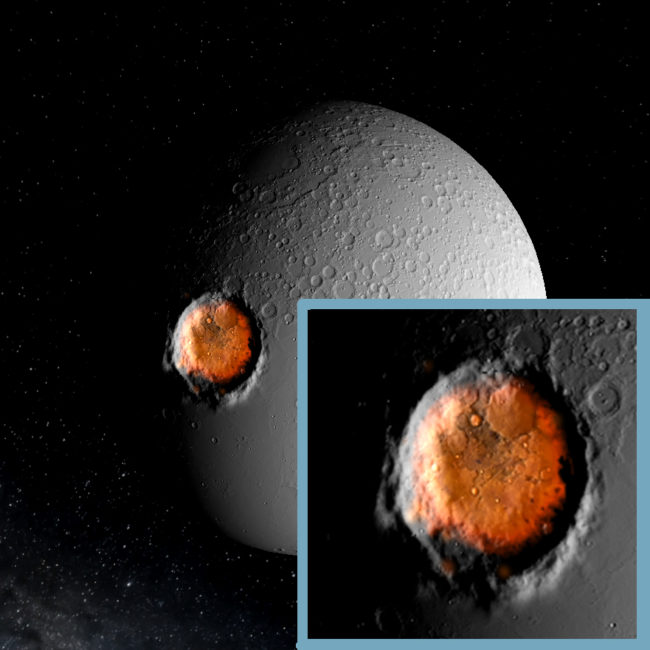
Work-in-progress screenshot of the new impact visuals in Universe Sandbox ²/span>
Opportunities, Not Limitations
The first rule of self-criticism (which we didn’t follow above) is that it’s necessary to throw things in a positive light. Drawbacks, weaknesses, limitations — they’re all opportunities for improvement! Often times these simulations of historical events are great tests of the simulation. When we put in the known properties and velocities for a set of bodies, does the simulation play out similarly to how it did in observed reality? If something is different, how can we improve the simulation in order to achieve the same results? But if instead it’s remarkably similar, as it sometimes is, then we can give ourselves a nice pat on the back and sit back and relax… Until we load a different simulation and notice another opportunity for improvement. We often say that building a universe simulator is never a completed job. A big chunk of that lies within our commitment to continuously notice where we can improve, and then take the necessary steps to make these improvements.
The above items are all on our to-do list, though we can’t promise when they will be added to Universe Sandbox ². Learn more about what we’re working on in our 2017 Roadmap.
For the latest Universe Sandbox ² news, follow us on Twitter and Facebook.
Ciao, Cassini | Update 20.2
Sep 14th

Run Steam to download Update 20.2, or buy Universe Sandbox ² via our website or the Steam Store.
November 3: Updates 20.2.3 and 20.2.4 are small updates which add two sims from the latest Vsauce video as well as a few improvements and bug fixes.
November 2: Update 20.2.2 is a minor update which includes a number of improvements and bug fixes.
October 5: Update 20.2.1 a minor update which adds a Cassini spacecraft model, Quicksave & Quickload (F5 & F9), and a number of smaller improvements and fixes.
On September 15, 2017, the world says goodbye to the Cassini spacecraft as it ends its historic mission with a final plunge into Saturn.
During its 13 years orbiting Saturn, Cassini made a number of invaluable discoveries about the planet, its rings, and its moons.
We now know that massive geysers covering the south polar region of the moon Enceladus shoot icy particles into space, forming most of Saturn’s E-ring and hinting at a massive, subsurface ocean. And we now know that the surface of Titan, Saturn’s biggest moon, shares a surprising number of characteristics with Earth, including dunes, mountain ranges, rivers, lakes, and seas.
With its array of sophisticated instruments, Cassini watched as storms raged on Saturn and seasons changed. It discovered eight new moons, provided insight into the behavior of its famous rings, and completely changed our understanding of its magnetosphere. The mission has been extended twice and now Cassini has been in orbit nine years longer than originally intended. Its fuel is nearly gone and so, to prevent possible contamination of any of the moons, its course has intentionally been set for disintegration in Saturn’s atmosphere.
So now we say ciao, Cassini. Thanks for all of your work.
And thanks to all of the hard-working scientists from NASA, the European Space Agency, and the Italian Space Agency who made the Cassini mission possible.
See Cassini’s final hours in Universe Sandbox ²
Home > Open > Core/Historical > Cassini collision with Saturn on September 15, 2017
Home > Tutorials > Science > What Is Cassini’s Grand Finale?
This update also includes a number of smaller improvements and bug fixes.
Check out the full list of What’s New.
For the latest Universe Sandbox ² news, follow us on Twitter and Facebook.
